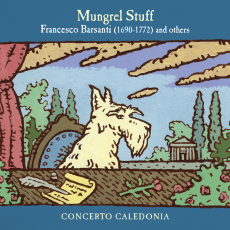Concerto Caledonia - Mungrel Stuff - Fanfare
A fascination with all things Celtic was widespread in 18th-century Britain, the songs of Scotland, Wales, and Ireland hinting at an exoticism that even musical immigrants from the continent found difficult to resist. Among the more famous examples are the Scottish ballads that found their way into The Beggar's Opera, Johann Christian Bach's introduction of the popular tunes into the finales of his piano concertos, and, of course, the folk-song arrangements made by Haydn and Beethoven for the publisher James Thomson. The present disc concentrates largely, if not exclusively, on the cross-fertilization between Scottish music and poetry effected by some of the Italiancomposers who resided in Britain during the 18th century.
The repertoire chosen shows that - while it was mostly Italians who shivered in a kilt - the traffic was by no means one way. As a young man William McGibbon travelled to Italy, returning tobecome a respected member of Edinburgh musical society. His experience left him capable of cashing in on the craze for Corelli by turning out a skillful, if brief four-movement sonata da chiesa modeledon those of the Italian master. The performance is robust, if somewhat lacking in finesse. If McGibbon 's work conveys no evidence of its origin, another example of the use of pure Italian style does by dint of setting a Scottish text in the form of a chamber cantata. The result, by the little-known Lorenzo Bocchi, an Italian who arrived in Edinburgh around 1720, is mildly interesting, but shows far less capability in realizing a fusion than the cantatas of John Clark, another Scottish composer who visited Italy and drank deeply from the fount of its music. (A disc of Clark 's music, also performedby Concerto Caledonia, was well received by the present writer in Fanfare 22:2.) It is pleasingly sung by soprano Mhairi Lawson, the better of the two solo singers. More convincing examples of "mungrelization" are to be found in the four settings of traditional songs by a familiar name, Francesco Geminiani. Although Geminiani spent many years in London, he is not known to have visited Scotland. His arrangements are fascinating, not only for the manner in which he decks the songs out with elaborate Italianate instrumental introductions and ritornelli, but also because he incongruously tried to pass the tunes off as being the work of David Rizzio (Riccio), the Italian-born secretary of Mary, Queen of Scots, who was murdered in 1566. Geminiani 's compatriot Francesco Barsanti (1690-1772) has rather stronger links with Scotland. He not only spent eignt years in Edinburgh, where he produced the Collection of Old Scots Tunes that provide the source of the tunes recorded here, but married a Scot. The melodies, which include the haunting Johnnie Faa in addition to a couple of Sassenach fakes, were notated by Barsanti in ornamented versions, not, according to David McGuinness's helpful notes, to "Italianize" them, but in an effort to try to record the tunes as he heard them. The pieces are mostly performed in an improvisatory, almost folksy style and to my mind elicit some of the most appealing playing on the disc, with some very good flute playing from Chris Norman. The most extended work here is the violin sonata by the eccentric and self-aggrandizing Francesco Maria Veracini, who arrived in London in 1714. According to Burney he was (withTartini) considered the greatest violinist of the day, an opinion with which Veracini had been all too ready to concur. Like Geminiani, he never visited Scotland, but imbibed enough of the craze for Scottish tunes to include the famous Lass of Peaty's Mill (heard here in Geminiani 's winning arrangement) in one of his operas, and a set of variations on "Tweedside" in the ninth of his Sonate accademiche, op. 2. Sadly, the hefty, rough-edged performance sounds as if it was hewn from Scottish granite; certainly it is no match for that of the Locatelli Trio in its complete traversal of op.2 on Hyperion. I have perhaps devoted more space to this disc than its admittedly thin musical interest warrants. It will certainly prove valuable to fellow students of 18th-century British musical history, but otherwise its appeal is likely to be restricted to Scots (home-based or expatriot) who want to hear how their popular tunes came to form part of an "art" repertoire during this period.

